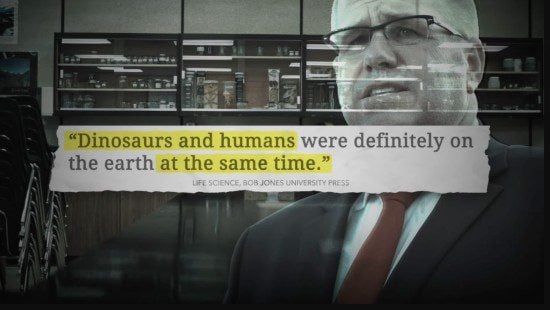“Dinosaurs in new Jurassic World film divide the palaeontology world” Chi Chi Izundu writes for the BBC.
Izundu quotes paleontologist Dr. Gareth Dyke, who complains that in the movie, “the raptors, velociraptor and the other theropod dinosaurs have been reconstructed by the people that made the movie without feathers, which we know is not correct. … All of these theropod dinosaurs, this group that includes the meat-eating carnivorous dinosaurs, probably had feathers all over their bodies.”
The problem, apparently, is that when the first Jurassic Park movie was made in 1993, we didn’t yet know about feathered theropods. Now we do, but the portrayal of these dinosaurs in the sequel is guided by continuity with the earlier film, not by what science has learned since then.
“Twenty-two years ago that’s what we thought or that’s what the fossils were telling us dinosaurs may have looked like,” [Dyke] says.
“But then we didn’t have any good fossils that showed us what the skin covering of these animals was like. So people guessed at what their colors were and what their skin covering looked like.
“And now we know that based on really good fossils, some of them from China, some of them from other parts of the world, and new kinds of imaging techniques and analytical techniques that have been developed over the last 23 years that these dinosaurs were covered in feathers of various kinds.
“We know quite a lot about what their body colors would have been like as well.”
This is a good problem. Or, at least, it’s a problem with a good cause. We’re learning. We know stuff today that we didn’t know in 1993. By any measure, that’s a Good Thing. Learning more is good.
But not everyone shares that view. For some folks, learning more is scary. From their point of view, learning something new means raising questions about something old — and they’re certain we must never, ever do that. They want everything to be known, and to have been known, and all knowledge to be settled. Thus, from their perspective, learning anything new about the world is unsettling.
That’s why our friends at Answers in Genesis look at all that science has learned about dinosaurs since 1993 and simply rejects it. “Is Jurassic World Wrong for Portraying Dinosaurs Without Feathers?” Avery Foley asks in an article at the young-Earth creationist website. Foley says that the idea of feathered dinosaurs is “nothing short of bizarre” and “quite ridiculous.” Scientists like Dr. Dyke, she suggests, are just lying and making stuff up when they talk about new fossil discoveries and imaging technology.
All this talk of feathered dinosaurs, Foley asserts, is just evolutionist propaganda to trick people into believing that dinosaurs evolved into birds. That’s just nonsense, Foley says, because dinosaurs are dinosaurs and birds are birds. “They are completely and utterly different.” Duh. And because, “In a biblical worldview, birds would have actually been around before dinosaurs ever walked the earth — a whole day before!”
In a biblical worldview, we do not expect to find feathered dinosaurs. Currently the evidence does not support the idea that dinosaurs were covered in feathers. Now while we may not know for sure what dinosaurs looked like, what we do know is that birds did not evolve from dinosaurs. They — like dinosaurs — were specially created by God in the beginning to reproduce according to their kind.
I love that first sentence: “In a biblical worldview, we do not expect to find feathered dinosaurs.”
This is an accidental admission of what all this talk about “a biblical worldview” really means — whether it’s from the creationist crackpots of Answers in Genesis or the pseudo-intellectual babble of pretentious Francis Schaeffer wanna-bes. A “biblical worldview” is about what we expect. It’s a short-hand buzz word meaning that when we view the world, we will refuse to see anything that does not conform to our expectations.
If we don’t “expect” dinosaurs to have feathers, then the discovery that they did have them is simply unacceptable — “bizarre” and “ridiculous.”
But where did these world-shaping expectations come from? Despite the endless repetition of the word “biblical,” they don’t come from the Bible. The Bible’s got nothing to do with it. These expectations come from folklore and from pop culture. When Foley writes, “In a biblical worldview, we do not expect to find feathered dinosaurs,” what she really means is “We know what dinosaurs look like because we had coloring books when we were little and because we watched the first Jurassic Park movie in 1993 and so we do not expect to find feathered dinosaurs.”
Joel Duff has a good discussion of some of the other errors and contradictions in Foley’s AIG piece: “The Dangers of Poor Scholarship: A Creationists’ Take on Feathered Dinosaurs.” But as interesting as all that is, I’m still more intrigued by what scientists are actually learning than by what creationists are refusing to learn.
Again, back in 1993, scientists hadn’t yet learned what they know today about feathered dinosaurs. So the filmmakers of Jurassic World had a choice. They could incorporate this new information and change the look of the dinosaurs from that of the first film, or they could opt for continuity in the sequel even though that means sticking with the misrepresentation of the velociraptors from the original Jurassic Park.
But they’re not the only storytellers struggling with this clash between this new information and the desire for continuity with audience’s expectations.
George R.R. Martin began writing the first volume of his A Song of Ice and Fire series in 1991 — and thus his description of dragons in the story was based only on what science knew at that time.
Today, 24 years later, Martin’s series has sold more than 60 million books and the HBO adaptation, Game of Thrones, has emerged as a pop-culture phenomenon. But — as fans of the show saw in the thrilling conclusion of last week’s episode — Martin’s portrayal of dragons is still stuck in the early 1990s. Daenerys’ children — Drogon, Rhaegal and Viserion — look amazing, but they’re scaly and their wings are bat-like, not feathered.
Granted, dragons are carnivorous but may not, strictly speaking, be theropods. I’m not clear about how, exactly, they’re related to dinosaurs, and whether or not they’re closest to forms of dinosaurs that science now suggests ought to have feathers. I’m not a scientist, man.
Still, though, given what we’ve learned and the leaps of progress in paleontology in recent decades, I have to ask: Scientifically speaking, should the dragons in Game of Thrones have feathers?
Maybe that’s an absurd question. But asking what science has to say about dragon feathers isn’t any more absurd than asking what the Bible has to say about dinosaur feathers.













